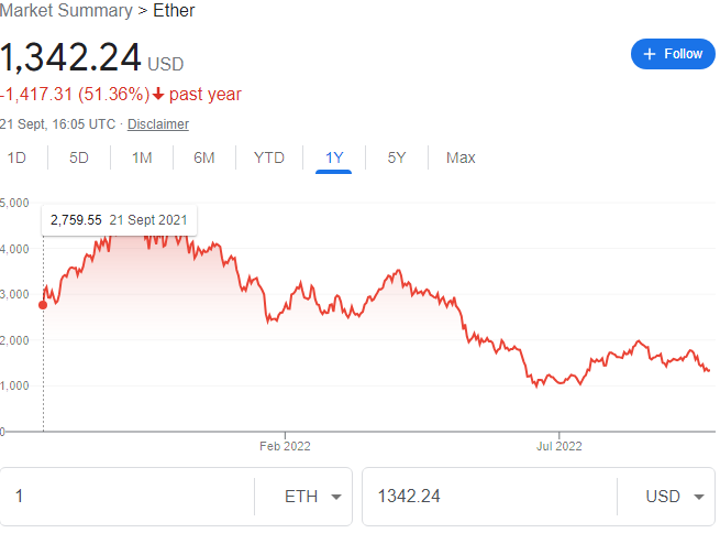Ethereum’s Merge has seen miners desert as the SEC circles to claim regulatory control. With rate rises coming, is Ethereum destined to fall?
Ethereum’s Merge, designed to change its foundation from a proof-of-work to proof-of-stake altcoin, was at last completed last week.
Abandoning its energy intensive miner-based system has become somewhat of a crypto milestone, followed by a 41,000-strong YouTube Merge watch party sponsored by the Ethereum Foundation, and featuring talks with Ethereum co-founder Vitalik Buterin.
But instead of rocketing, Ethereum has sunk by more than $300 over the past week to just $1,342 today. This drop is just the latest this year; Ethereum is down more than 50% from its record $3,462 high of November 2021.
But is the Merge a disaster, or could now be the perfect buying opportunity?
Ethereum price: regulation and profit-taking
Negatively, a comment in a US Securities and Exchange Commission lawsuit now hints the regulator feels the US might have jurisdiction over the altcoin.
While the details of the suit are largely irrelevant to retail investors, it mentioned that the Ether transactions relevant to the case ‘were validated by a network of nodes on the Ethereum blockchain which are clustered more densely in the US than in any other country. As a result, those transactions took place in the US.’
This suggests that the SEC could press for US-based control over what is meant to be a decentralised currency. When asked, a spokesperson said only that the SEC does not have a comment ‘beyond public filings.’
This could become a complex and legally grey area, as according to DeFi Llama data, over $40 billion is sitting in decentralised-finance apps on the Ethereum network. And according to Etherscan, only 46% of all Ether nodes are in the US, followed by 19% in Germany. The US boasts only a plurality, not a majority.
But worryingly, SEC Chair Gary Gensler has already argued that staking under the new framework to generate further returns could mean that Ethereum falls under its purview through securities laws. Indeed, Bitbank crypto analyst Yuya Hasegawa believes all ‘PoS crypto may fall under SEC’s scrutiny.’
However, any attempt to regulate the currency could simply see Ether nodes migrate out of the US, and the likelihood that an international regulatory framework will develop instead still remains higher, as the US will not want to lose technological advancement to its economic competitors.
Former CEO and current Executive Chair of MicroStrategy, Michael Saylor, argues that proof-of-work is a better way of developing a digital commodity, as proof-of-stake coins are by their nature securities.
Putting distance between ETH and BTC for regulatory purposes, he retweeted WSJ comments that ‘Ethereum’s big software update on Thursday may have turned the second-largest cryptocurrency into a security in the eyes of a top U.S. regulator.’
Worse, Ethereum miners are dumping the coin at record levels, with 17,000 sold in the past week alone according to OKLink data. It’s possible a negative feedback loop has been created where miners waiting for positive price action instead sold off when it remained flat.
And according to The Defiant, miners have also been driven away because the Merge eliminated 13,000 ETH in daily rewards, leaving just 1,730 now being created each day. And these remain non-withdrawable until the next major upgrade.
However, ESG funds can now invest in Ethereum as its electricity usage has been cut by 99.9%. And while supply is temporarily higher, the deflationary effect caused by the 2021 burning mechanism combined with the Merge will eventually see a supply shortage for institutional investors.
Long-term, Ethereum may still be an excellent investment.

Federal Reserve influence
However, this may be discounting the wider macro environment. Bloomberg analyst Mike McGlone thinks the Federal Reserve’s inflation ‘sledgehammer’ could send Ethereum to ‘$1,000 or even get a bit lower.’
The analyst argues that the Merge was a ‘buy the rumour, sell the news event,’ which got ‘too hyped,’ and that the eventual wider crash will be ‘worse than the Great Financial Crisis.’ However, he also expects that a recovery to record highs could take place by 2025.
Invesco chief global market strategist Kristina Hooper concurs, saying ‘The Fed has been the key driver of the stock market this year, and it has been mostly bad.’
Meanwhile, CoinGecko co-founder Bobby Ong thinks ‘the overall market decline, including for ETH, was due to the Federal Open Market Committee meeting taking place…markets are expecting further interest rate hikes to get inflation under control, resulting in the pre-emptive selling of risk assets.’
As miners turn to other altcoins for better returns, and crypto investors flee to the relative safety of Bitcoin, Ethereum may find the upcoming recession brings frosty reception.
However, its position as the underlying crypto for the Metaverse and NFT projects could make it a buying opportunity during the ongoing dip.
Ultimately, the depressive effect of the Merge is down to an individual investor’s philosophical bent.
Has it ruined the altcoin, or will Ethereum’s newly minted green credentials be key to the prophesied flippening?
This article has been prepared for information purposes only by Charles Archer. It does not constitute advice, and no party accepts any liability for either accuracy or for investing decisions made using the information provided.
Further, it is not intended for distribution to, or use by, any person in any country or jurisdiction where such distribution or use would be contrary to local law or regulation.
